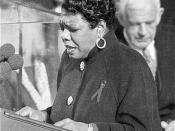We are all familiar with the widespread novel by Maya Angelou, I Know Why the Caged Bird Sings. Yet, do we really know? The connotations of the title can drastically alter the perspective of the novel and the meaning it leaves on the readers. Angelou wrote an amazing and entertaining autobiography, about her hard life growing up as a black girl from the South. Among the hardships are her "cages". These are things that keep people from succeeding in life and being everything they want to be. Some of Maya Angelou's cages include being black in the 1940's and her overbearing grandmother. The word "cage" can help to outline other major diction techniques in which Angelou utilizes. Understanding the varied connotations of the word "cage" and the theme it threads throughout the novel gains us some insight into the historical and literary analysis of Angelou's popular novel.
First, a major "cage" from Maya Angelou's youth was that she was black in a prejudice southern town. Maya has recounted in her book the times when she was discriminated against. When she was working for a white woman named Mrs. Viola Cullinan, Mrs. Cullinan started calling her Mary, "That's [Margaret] too long. She's Mary from now on."(page 91) One of the most important aspects of a person is their name. It is
a great insult for someone to change your name, without your consent, just because someone wanted too. Angelou directly puts this incident in the novel, identifying her first major cage. If Maya was white Mrs. Cullinan would not have changed her name and she did it only because of her racist friends and attitudes. Even some of the white adults who supposedly supported her had hidden their racist messages in seemingly nice speeches. Maya conveys the...


